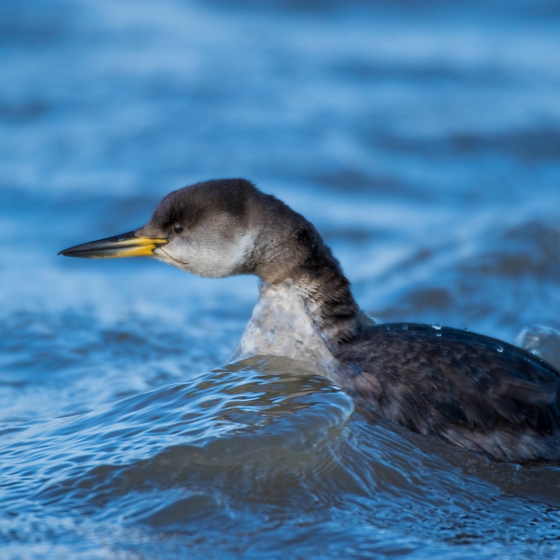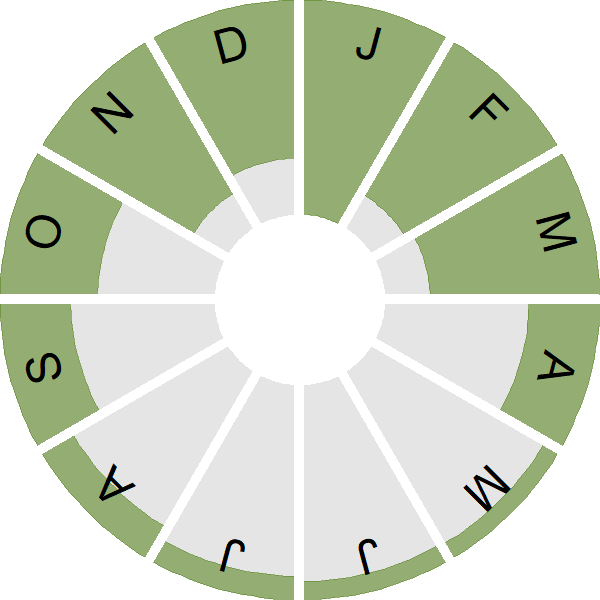Red-necked Grebe

Introduction
This medium-sized grebe is a scarce winter visitor, mainly to the coasts of eastern Scotland, and eastern and southern England.
Difficult to see for the casual observer, Red-necked Grebes are found in very small numbers on the sea from October to March. In winter plumage they can be tricky to separate from their larger cousin, the Great Crested Grebe, being mainly shades of grey, although the short, thick neck is a good feature.
Atlas data suggest a wintering population of around 50–60 birds is present in most years. Breeding attempts by this predominantly European species are sporadic and very rare, which is a shame as the lovely rufous neck and black and white face make this a striking bird in breeding plumage.

Key Stats
Identification
ID Videos
This section features BTO training videos headlining this species, or featuring it as a potential confusion species.
Winter Grebes
Songs and Calls
Song:
Status and Trends
Conservation Status
Population Size
Population Change
Red-necked Grebes are regular, but scarce, winter visitors to the UK. The majority of birds are observed along North Sea coastlines and the south coast of England, with only sporadic sightings inland. WeBS data WeBS data indicate that numbers of Red-necked Grebes peaked in the mid-1990s, after which there has been a dramatic decline in recorded sightings across the UK.
Distribution
In winter, Red-necked Grebes can mostly be found along North Sea coasts from Angus to Kent, along the south coast of England, and at scattered at inland sites, mainly in eastern England. They occasionally attempt to breed but most summer records are of single individuals.
Occupied 10-km squares in UK
2007/08–10/11
or view it on Bird Atlas Mapstore.
2008–11
or view it on Bird Atlas Mapstore.
European Distribution Map
Distribution Change
Change in occupied 10-km squares in the UK
from 1981–84 to 2007–11
or view it on Bird Atlas Mapstore.
from 1968–72 to 2008–11
or view it on Bird Atlas Mapstore.
Seasonality
Red-necked Grebe are mostly scarce winter visitors, present from early autumn through to late winter and early spring; odd individuals summer in some years.
Weekly pattern of occurrence
The graph shows when the species is present in the UK, with taller bars indicating a higher likelihood of encountering the species in appropriate regions and habitats.

Movement
Britain & Ireland movement
Foreign locations of birds ringed or recovered in Britain & Ireland
Dots show the foreign destinations of birds ringed in Britain & Ireland, and the origins of birds ringed overseas that were subsequently recaptured, resighted or found dead in Britain & Ireland. Dot colours indicate the time of year that the species was present at the location.
- Winter (Nov-Feb)
- Spring (Mar-Apr)
- Summer (May-Jul)
- Autumn (Aug-Oct)

Biology
Productivity and Nesting
Nesting timing
Egg measurements
Clutch Size
Fledging
Survival and Longevity
Survival is shown as the proportion of birds surviving from one year to the next and is derived from bird ringing data. It can also be used to estimate how long birds typically live.
View number ringed each year in the Online Ringing Report.
Survival of adults
Biometrics
Wing length and body weights are from live birds (source).
Ring Size
Classification, names and codes
Classification and Codes
- Order: Podicipediformes
- Family: Podicipedidae
- Scientific name: Podiceps grisegena
- Authority: Boddaert, 1783
- BTO 2-letter code: RX
- BTO 5-letter code: RENGR
- Euring code number: 100
Alternate species names
- Catalan: cabussó gris
- Czech: potápka rudokrká
- Danish: Gråstrubet Lappedykker
- Dutch: Roodhalsfuut
- Estonian: hallpõsk-pütt
- Finnish: härkälintu
- French: Grèbe jougris
- Gaelic: Gobhlachan-ruadh
- German: Rothalstaucher
- Hungarian: vörösnyakú vöcsök
- Icelandic: Sefgoði
- Irish: Foitheach Píbrua
- Italian: Svasso collorosso
- Latvian: pelekvaigu dukuris
- Lithuanian: rudakaklis kragas
- Norwegian: Gråstrupedykker
- Polish: perkoz rdzawoszyi
- Portuguese: mergulhão-de-faces-brancas
- Slovak: potápka cervenokrká
- Slovenian: rjavovrati ponirek
- Spanish: Somormujo cuellirrojo
- Swedish: gråhakedopping
- Welsh: Gwyach Yddfgoch
Research
Causes of Change and Solutions
Causes of change
The European breeding population of Red-necked Grebes, from which our winter visitors derive, is decreasing; however, the drivers behind this change are unknown [BirdLife International 2021].
More Evidence
More evidence from Conservation Evidence.com
Partners
Citing BirdFacts
If you wish to cite particular content in this page (e.g. a specific value) it is best to use the original sources as linked in the page. For a more general citation of the whole page please use: BTO (20XX) BirdFacts Species: profiles of birds occurring in the United Kingdom. BTO, Thetford (www.bto.org/birdfacts, accessed on xx/xx/xxxx).

